As an indie publisher, I rely on the POD (Print on Demand) printers. Many indies make most of their money from ebook sales. But for children’s books, the market has consistently been print-driven with only 10-25% of income from ebooks. That can vary widely, as some authors do very well on the Kindle Unlimited platform. But 10-25% is probably a good average. This discussion centers around how indies provide print books to customers. While I’ll talk about full-color picture books, this POD strategy also applies to my novels.
POD Printing
POD means that a book is uploaded to a printer where it’s held until someone orders the book, i.e. there’s a demand for the book. Once ordered, the book is printed. Most POD printers will drop ship the book to the customer for you. It’s slick. You never touch the book. The appeal of this printing method is that you do nothing to fulfill the order. You spend your time on writing/producing the book and then on marketing. The printing and shipping—the fulfillment—is done by the POD printer.
The biggest disadvantage of POD printing is that printing costs are significantly higher per copy. However, the actual deliver-to-customer cost can be reasonably comparable because for POD there’s no cost of shipping, warehousing, fulfilling, and associated costs of listing a book on a site such as Amazon. Offset printing is generally considered to be the best quality printing available; printing overseas is generally considered to be the best price point. But for those who want to simplify life, POD is a profitable alternative.
However, all of the POD printers are also distributors. They take a percentage (10-25%) to distribute books to the market. Your book is considered a wholesale sale from the printer to the distributor (even if the distributor is also owned by the printer).
IngramSpark wholesales its POD books to Ingram Wholesale, the biggest book wholesaler in the U.S. Ingram Spark charges for both printing and distribution. If you use their Aer.io online bookstore, you pay the distribution fee, too. Then Ingram Wholesale fulfills the book, taking care of ordering, payment, and shipping.
If you POD with KDP Print (Amazon), they wholesale your book to Amazon.com. KDP charges both printing and distribution fees. Amazon.com fulfills the book, taking care of ordering, payment, and shipping.
The advantages of POD are many! You have less upfront costs because you don’t invest in a large print run that has to be warehoused. When a book is ordered, you never touch it; the system is slick and seamless, making sure the customer receives your book quickly. You just collect the profits (which POD companies tend to mistakenly call royalties.)
The disadvantage is clear, as well. You don’t “own” the customer or the retail environment. Amazon.com sets prices and their policies can and do change often. No customer information is ever shared with the book publisher (you!), so you’ve no idea about your customer or any way to develop a relationship or encourage follow-up sales.
For many, that disadvantage means little as they only want to write/publish a book and collect revenue from the sales. But for those who want independence from Amazon or other wholesalers, it’s frustrating.
The Hunt for a New POD Strategy
I’ve hunted high and low for a POD printer that would 1) only charge for printing, and 2) would fulfill the order by sending the printed book to the customer.
I finally found one, and it was a surprise!
LuluXpress + Shopify
One POD printer who’s been around a while is Lulu. In April 2018, Lulu announced the creation of LuluXpress, an app that would link their services to a Shopify store. (NOTE: Lulu still provides POD with distribution. I’m not talking about that here. I’m only talking about the LuluXpress app for Shopify.) Shopify is a well-respected online ecommerce platform for creating on online store. With this integration, LuluXpress will act as a printer and will fulfill the order by shipping books to the customer. Period.
What? I read and reread their information. Where was the distribution fee?
They do NOT charge a distribution fee. They ONLY charge a print fee and a shipping fee.
Wow! Through a Shopify store, I would be in total control of the retail process. I could choose an email marketing platform and connect it to the store. I could develop relationships with customers. I could set pricing MY way.
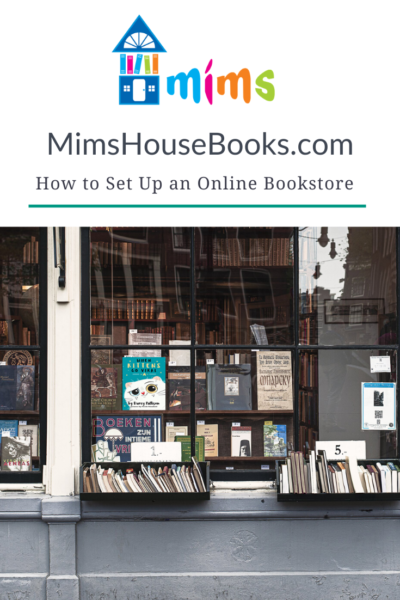
An eCommerce Store?
The downside? You must run an online store.
This isn’t for everyone. I don’t recommend it for beginners or for those with a small catalog. But for anyone who has mastered the other platforms and still wants to dig into the sales process, this is an amazing option.
Print Quality
My first cautious step was to set up one color picture book in both paperback and hardcover and order a copy. Wow!
Here’s the amazing thing! It’s gorgeous.
For a full-color children’s book, the best paper is a coated paper, which allows the interior pages to be a smooth matte finish. At Ingram, Standard70 printing uses a 70# uncoated paper. KDP is similar. LuluXpress offers an 80# coated paper, which you can choose for either premium print or standard print. For paperbacks, I chose standard printing with the 80# coated paper; for hardcovers, I used premium printing with 80# coated paper. (For novels, LuluXpress offers 60# uncoated paper.)
Many POD companies use the uncoated papers because they are less expensive. But they have a rougher texture and don’t absorb color as well. Colors are muted, instead of vibrant. For novels—which are probably the most common printed book—it doesn’t matter. But for full-color picture books, the preferred paper is a coated paper which absorbs the ink for a more vibrant result.
When I received my first trial book, I was shocked. LuluXpress’s premium print almost rivals offset printing, the standard against which every print job should be compared. Comparing LuluXpress’s standard and premium prints, there’s a noticeable difference. For standard print, details aren’t as clear. But these were paperbacks, which most people understand will not be printed in as high a quality. And the quality was much better than other POD books printed on uncoated paper.
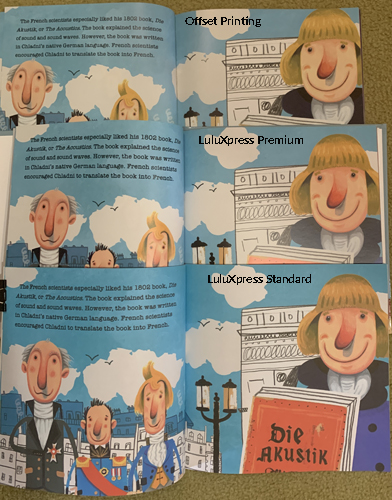
Companies like Ingram or KDP will add extra pages at the end of a picture book. The companies say they need those pages to add a bar code that will indicate where the book has been printed. These are generally hated by indie publishers. And, by the way, you’re charged for those extra pages. I create a standard 32-page picture book, but I’m usually charged for a 34-page book. In the past, I’ve just shrugged and considered them part of the pain of POD printing.
No longer. LuluXpress doesn’t add those dreaded extra pages. Instead, they add a narrow barcode on the last page almost in the gutter. It’s almost unnoticeable.
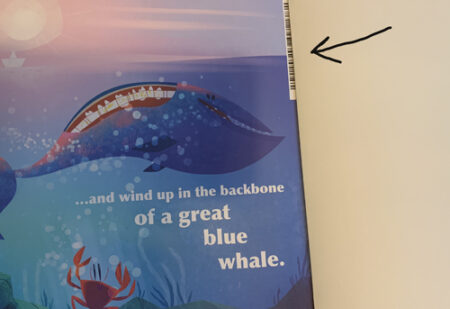
Gorgeous coated paper with excellent printing. No extra blank pages.
What about reliability and timeliness of delivery?
You Made Me Look Good!
During May, 2020, at the height of the COVID-19 epidemic, an educational distributor contacted me. Their customer, a school district in North Carolina, usually gave each elementary student a summer book. They wanted to give my paperback book, NEFERTIT THE SPIDERNAUT, to each fourth grader. That was an order of 1672 books! That’s exactly the kind of special order that keeps my business going. I had to work it out despite COVID.
At the time, Ingram said it would take about three week to fill an order.
LuluXpress filled the order within seven days. The distributor ordered from five publishers to fill the school district’s order. My order was received first. Thanks, LuluXpress! You made me look good! And, they were the well-printed 80# paper version without the hated extra blank pages. What an amazing thing that kids are reading my book this summer.
MimsHouseBooks.com
The LuluXpress app is only available for Shopify stores. Since January, 2020, I’ve been working to develop a store that will be profitable, and it’s a daunting process. Developing traffic, advertising, integrating an email program, and figuring out how to merchandise (how to present books or book collections) is a whole new learning curve. And frankly, there’s not much help out there because so few are doing this for books. I have to re-interpret everything for selling children’s books online. But I’m finding it a creative (and daunting!) and fulfilling process on its own.
By the way, I also sell ebooks and audiobooks, with fulfillment by Bookfunnel.com. That’s another fantastic arrangement! And I’m cautiously adding some merchandise – tshirts and stickers.
I’m in charge. Finally. In my indie publishing career, I’ve longed for the independence that Mark Coker says we need. Finally, I decide everything from idea to reader. By starting my online bookstore at MimsHouseBooks.com, the buck stops here. I will live or die by my creative and business decisions. Hurrah!
As Mark Coker says, “Shouldn’t the conversation be about how to please readers?” Finally, I’m having THAT conversation! (And it’s a hard, multi-faceted discussion, believe me!)
Jumpstarting an Online Store in the Midst of a Pandemic
I started the online bookstore in January 2020. With the onset of COVID-19 and schools closing early in March 2020, I felt passionately that I needed to support families and educators. From March 23 to June 1, I set all my ebooks and audiobooks to free, giving away over 10,000 books.
An unintended, but nice side benefit was that it created traffic to the nascent bookstore, giving lots of feedback on page design, merchandising, advertising and more. With the knowledge we learned, we’ll continue to develop the online platform and hope that by Christmas season, we’re dialed in to make some profit.
Surprising Benefits
An unexpected benefit of the store is the ability to order from LuluXpress for large orders. We’re funneling special sales through the store to take advantage of the excellent printing and fulfillment from LuluXpress. The quality is so much better for picture books!
Another unexpected benefit is that LuluXpress ships internationally. I’ve sent books to people in France, UK, and Canada with no problems. LuluXpress says they will ship anywhere that FedEx delivers.
The Money
OK, you’re all wondering if the pricing will work. Let’s take an example of an 8.5” x 8.5” full-color paperback picture book, 32 pages. Because profit margins are so small with my current POD printers, I put a list price on a paperback of $11.99. This is high! I know that sales will be smaller as a result, but I can’t make a profit otherwise.
KDP figures your profits like this:
(Royalty rate x list price) – printing costs = royalty
(.60 x 11.99) – $3.65 = royalty
$7.19 – $3.65 = $3.54 royalty
LULU Xpress + Shopify figures your gross profits like this:
List price – print cost = gross profit
$11.99 – $3.29 = $8.70 gross profit
| POD Printer | Print charge | Distribution fee | Wholesale Discount | Other fees | Profit |
| KDP | $3.65 | 40% of list price; 60% for Expanded Distribution | Set by KDP | $3.54; Expanded $1.15 | |
| Ingram – either IngramSpark or LightningSource | $2.83 Standard Color 70 | 40% of list price | You set as 40-55% | Set up fees, and yearly distribution fees of $12/title | $4.36-$2.57 |
| LuluXpress + Shopify | $3.29 Color Standard 80# coated | DNA | DNA | DNA | $8.70 |
Another Unexpected Benefit
With that kind of profit margin, could I lower pricing to $9.99, a more reasonable retail price?
List price – print cost = gross profit
$9.99 – $3.29 = $6.70
Our Manufacturer Suggested Retail Price is still $11.99, because we still POD with KDP and Ingram. But on our store—go direct and save!—we offer a price of $9.99 for our paperback picture books.
Gross Profits – Not Net Profit
Remember! The profit listed here is “gross profit.” From that you must deduct your operating costs such as the Shopify store fees, email program, credit card fees, etc. But you decide how elaborate or simple you go on that. YOU are in charge! The profit margin is large enough to work with.
For now, I’m still leaving my titles as POD with Amazon and Ingram. I plan to develop the bookstores as another income stream. Will there come a time when I only do the online bookstore? I don’t know. For now, I just know that I’m in the game.
This is NOT for Everyone
Some people will not want to “bother” with an online bookstore. Fine.
Concentrate on what you love best.
Some people will not have enough titles to make it a reasonable effort. Fine.
Build up your catalog or backlist until it makes sense to try this.
Some people will be cautious about this (rightly so!). You need to learn the ins and outs of Shopify, how to advertise, customer service, and so much more.
It’s not for everyone.
Some people will be excited about the possibilities!
For me, I’m finally able to be the independent publisher.
I’m in charge of everything from idea to reader. I’m not doing this as a super-woman just to do it. When the profit is right, I will hire help. Not with the writing, because first and foremost, I’m a writer. That’s what started all this, and that’s what will end it all. I write. The rest is just there to connect a reader with my work.
But here’s what’s always been true: I care more about my work than anyone else ever will. If I don’t champion my books, who will?
Come! Visit my online bookstore at MimsHouseBooks.com
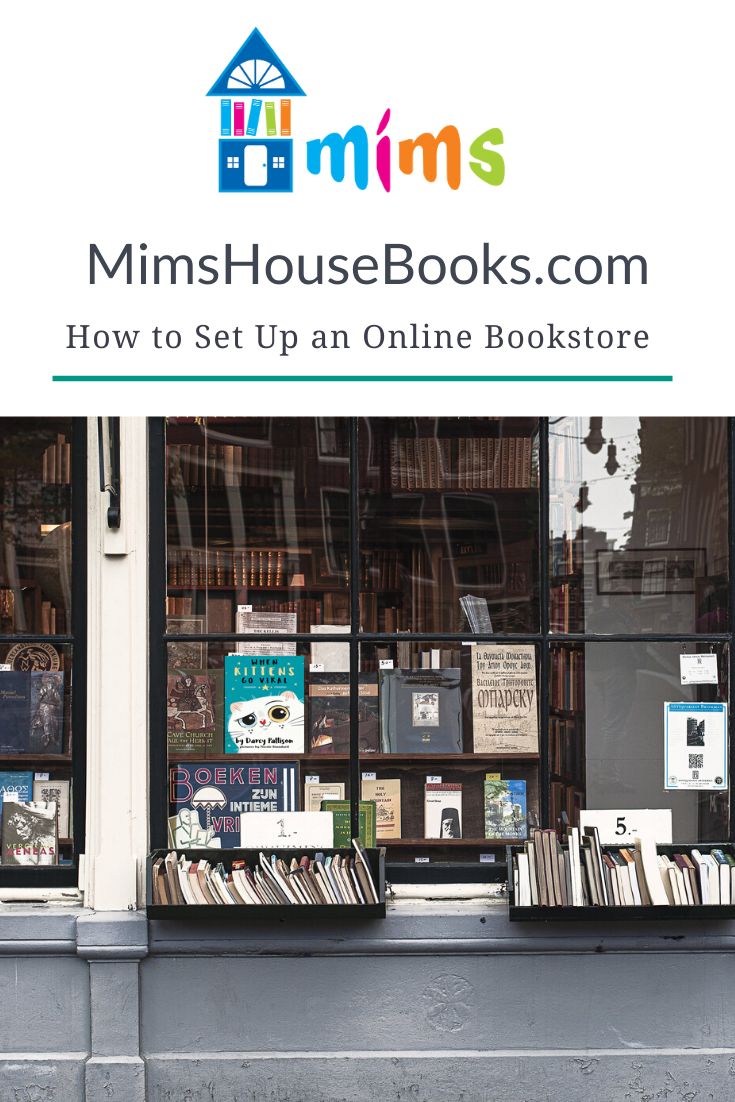
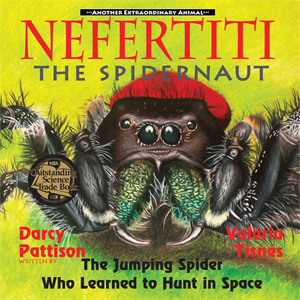
You’re such a leader! And, thank you for sharing your wonderful advice!
Great post, Darcy! What are the Shopify fees out of interest (I will research of course, but interesting to know here.)
There are different levels of Shopify. https://www.shopify.com/pricing
You can do a 14-day trial.
Basic is $29/month, and then you step up to $79/month.
There’s also a ShopifyLite, but I’m not sure if you can add the LuluXpress app to that one: https://www.shopify.com/lite
You’d have to check on that, but it’s only $9/month and allows you to sell by adding buttons to a blog post, social media post, etc.
This is fascinating! Thanks for sharing this glimpse of the future.
I was so excited after reading this, and then realized you completely omitted shipping. The fees that Amazon charge include prime shipping to it’s members. Also, Amazon often discounts it’s books and the discount comes out of their pocket.
With LuLu Xpress, you still pay shipping via Shopify. A single book in the U.S. is a minimum of $4 and shipping times are several weeks currently. The pricing is very similar of you consider shipping and feed. So the perk of LuluXpress would be retaining customer information. The huge downfall would be not being able to discount your book without losing money, and spending much more in advertising to direct people to your website ( I atead of Amazon PPC, where people are already shopping). There is no way you could sell your book for $9.99 like you suggested on Lulu XPress.
Extremely disappointed after getting my hipes up.
Thanks so much for this! I’m just starting to wade into the world of self-publishing, and this article is an enormous help.
We are interested in setting up a bookstore on LuluEx could you please let us know how we do this.
Very interesting, Darcy. I’m probably not the norm, but I enjoy the “fulfillment” part of our publishing business. I get a real sense of satisfaction packaging our books and sending them out into the world.
I really enjoyed your article. Very informative!
Thanks for sharing.
This is brilliant! Thanks Darcy!
Thank you! This is exactly the information I was looking for!
I love the joy that comes across from your empowerment. Thank you for sharing your story. This approach is not right for me, but you have helped many for whom this could work.
Luluexpress – does this work in the Uk as well as the US?
The information came via JAne Friendman
This is fantastic info! Thank you.
What do Lulu’s shipping fees tend to run? I can ship everything for around $3 via Amazon Seller Central.
I contacted LuLu and they said this:
The Lulu xPress App does work with Shopify Lite! The difference between Shopify Lite and the other plans is that you’re not getting a full online store with a shopping cart. Therefore, you can’t technically build a home for your brand in Shopify.
Rather, the Shopify Lite plan integrates with an already existent website or social media page.
For instance, if you’re running a blog on WordPress and decide to start selling some custom-made items, the Shopify Lite plan would allow you to keep that same blog and integrate some products – including Lulu xPress books – to sell on that site.
Kelly, of course, you have to do the math and include shipping. But I can definitely sell a picture book at $9.99 and still make a profit. Many stores include free shipping for orders of $50 or $100. If the shipping fee is spread across the several books it takes to make a $100 order, it’s very affordable.
Darcy
Thanks for checking, Anne.